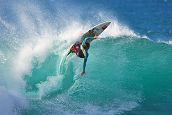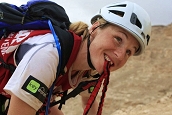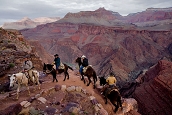On Nov. 7, Sturges
and three other professional kayakers – Steve Fisher, Tyler Bradt and Benny Marr
– became the first people ever to successfully navigate the infamous Inga Rapids
on the lower Congo River.
The 26-year-old Sturges grew up near Forks of
Salmon on the Salmon River in western Siskiyou County, where his parents own and
operate Otter Bar Lodge Kayaking School. He began kayaking at the age of 10 and
began competing at age 13. In 2003, he won the Junior World Championship in
freestyle kayaking and has won numerous other awards and honors throughout his
career, including a third-place finish in the 2011 Whitewater Grand
Prix.
The Daily News caught up with Sturges at his home in Etna on Wednesday
while he and local extreme sports photographer and cinematographer Matt Baker
worked on a new promotional video featuring Sturges running local streams and
rivers.
He explained that, with an average flow of 1.5 million cubic feet per
second (cfs) and maximum flows reaching as high as 2.5 million cfs, the Inga
Rapids are the highest volume rapids in the world. The flow was roughly 1.6
million cfs when Sturges and his teammates conquered the rapids.
In addition
to the extreme dangers inherent to rapids of this size, Sturges said that,
“Congo is the deadliest region on Earth,” due to the tribal and political
turmoil in the region.
“In the last 15 years there have been 6 million deaths
in the Congo,” Sturges said. “Going there as a westerner is extremely
dangerous.”
A rafting expedition led by French TV personality Phillipe de
Dieuleveult was the last to attempt the rapids in 1985. All six members of that
expedition disappeared on Aug. 6 of that year and are presumed to have died
either by drowning or assassination.
Sturges said his team’s expedition, with
sponsorship and support from Red Bull, took nearly five years to plan from
conception to completion. The permitting and diplomatic processes necessary to
visit the region and execute the expedition took nearly a year to
complete.
“A logistical nightmare,” Sturges said.
Then it was on to the
White Nile River in Uganda, where the team trained for nearly a month,
practicing with new equipment.
Bradt, the world-record holder for tallest
waterfall drop, invented a device called the “chastity belt” specifically for
this trip. The belt is an auxillary locking system designed to hold kayakers in
their boats under the extreme water pressures the team expected to encounter on
the Inga Rapids.
The team also carried compressed oxygen cannisters for
survival in extended submersion situations.
Sturges said veteran kayaker
Fisher was forced to use his canister once on the expedition when he was pulled
under water by an enormous whirlpool.
“He was under for a full minute,”
Sturges said.
By the time the team was geared up and ready to hit the Inga
Rapids, their ranks had increased. The full Inga descent team consisted of 11
people, including safety and support crews, a camera crew, a writer and
photographer from National Geographic and a helicopter to monitor and document
their plunge into the unknown.
“A big part of the mission was making sure we
documented it as fluently as possible,” Sturges said.
Each kayaker had
cameras mounted on their helmets and boats and a waterproof microphone on their
life vests in order to capture every splashing and thrashing moment.
Though
he has run some of the most difficult rivers in the world in over 30 countries,
Sturges said running the Inga Rapids was like nothing he’s ever
experienced.
“When you’re dealing with that much current and that much
volume, you’re dealing with features that nobody’s ever seen before,” he said.
“You occasionally encounter small whirlpools on some rivers, but these were 30
to 40 feet across. If you get sucked into those things you’re screwed. It’s just
so unpredictable and random.”
But he didn’t escape the trip unscathed.
Shortly after returning to the U.S., he realized he had contracted malaria. The
malaria weakened his immune system, allowing a flesh-eating bacteria (which he
also contracted in Congo) to take hold in a wound on his elbow, resulting in a
week-long hospital stay.
“I’m pretty much recovered now,” he said.
Sturges
is also an award-winning kayak filmmaker who usually produces films of his
expeditions with his company River Roots Productions. However, the film from
this trip will be produced and released by Fisher’s film company, Fish Munga
Productions.
Baker will be providing graphic design for the film and Sturges
will be assisting with the soundtrack, adding his experience as a hip-hop artist
to the mix.
According to Sturges, the film should be completed by the end of
March 2012.
“We’ll be going out and touring to promote the film when it’s
done, and we’ll probably be doing a showing in Mount Shasta,” he said.










